In 2015 when I decided I wanted to give film photography a try, it was the Leica M3 rangefinder that intrigued me the most. However, at the time I did not feel I was ready to plunk down the cash to invest in a Leica just to indulge a curiosity. After doing some reading around, I ended up deciding on buying a Nikon S2 of the same era, found a reasonable deal on eBay and made the purchase. The body came with the outstanding S-mount Nikkor H 50mm f/2 lens.
In the early 1950s, Nikon had made a name for itself as a reasonable alternative to Leica for photojournalists. American photojournalists covering the Korean War would pass through Tokyo, where they could purchase a workhorse Nikon kit on their way to Korea. Nikon lenses were viewed as exceedingly sharp and could give Leica a run for its money at a fraction the cost. Nikon cameras were also viewed as more durable and less finicky about maintenance than their Leica rivals, particularly important if you happen to be shooting in the midst of combat.
The Nikon S2 did not come out until after the Korean War in 1954, but by then, Nikon had already sealed its cred with professionals. Just before the launch of what was ostensibly to be the Nikon S2, Leica came out with its revolutionary M3. Nikon product designers quickly realized that their S2 was already obsolete before leaving the gate. So it was back to drawing board for Nikon to rapidly rethink the S2 and offer a compelling rival to Leica’s M3.
And so they did. The Nikon S2 mimics many of the features of the M3, and even improves upon some of them. Like the Leica, the S2 is a rangefinder. The viewfinder is beautifully clear and uncluttered with a 50mm frame whose magnification is 1x, compared to the M3’s .91x. The S2 is the only rangefinder I know of with a real-world magnification. You can look through the viewfinder with one eye and the real world with the other for a seamless view. Unlike the M3, the S2’s rangefinder patch has no clear border and can be difficult to discern, much like Canons of the day.
You have two means of focusing on the S2. You can twist the the focus ring on the lens or alternatively there is a spiffy little gear-like dial on the top-plate that that you rotate with your finger that also adjusts the focus. No such innovation on the M3, so eat your heard out, Leica!
Bizarrely, the aperture ring rotates with the focus ring, just like on the Leica Elmar 50mm f/2.8 collapsible lens, complicating changing and keeping track of aperture.
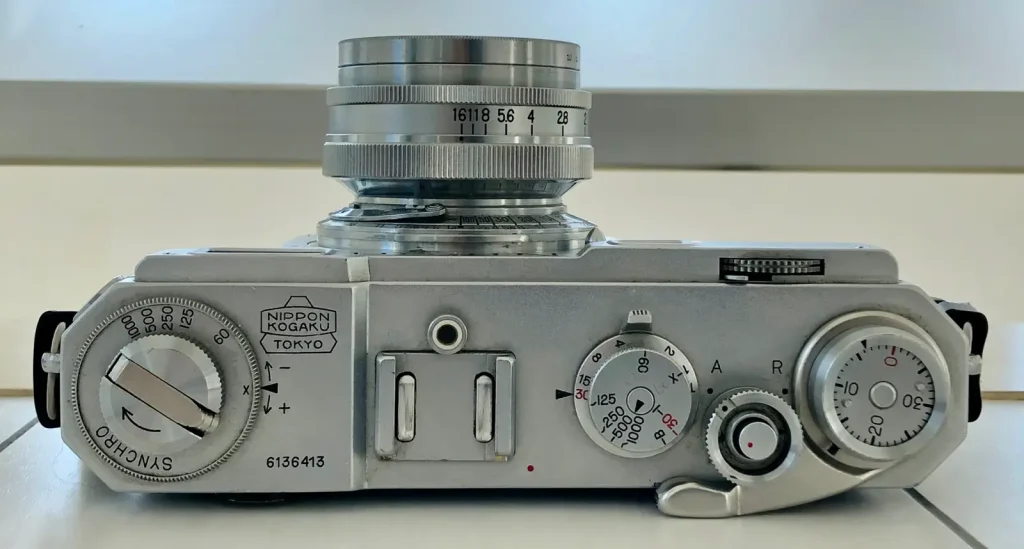
Film loading is a breeze. Like the Leica, you remove the bottom plate. However, the bottom plate is connected to the back, which slides off easily exposing the entire interior back of the camera. There’s no annoying door flap like on the Leica. Pop the film in, insert the film lead into a slot on the winding axle, and Bob’s your uncle, as they say! No fiddly M3 spool to load.
Imagine being in a war zone during a firefight having to deal with an M3 spool. What happens if you clumsily drop the thing in the mud and lose it?
Despite its merits, the S2 is no Leica. You are stuck with a fifty millimeter frame, and the frame does not correct for parallax as you focus like on the Leica. There are no additional frame lines for different lenses like with the Leica M3, even though Nikon offered a variety of S-mount focal length lens options. You had to buy an external finder for the flash mount. Nikon later introduced multiple finder frames in subsequent S series models, such as the much sought-after Nikon SP.
You set the shutter speed by lifting and rotating a spring loaded dial on the top of the camera, akin to the technology used in pre-rangefinder Leicas, like the IIIg for example. The shutter speed dial rotates as you advance the film, and then snaps back when you release the shutter. The shutter speed indicators don’t line up exactly with the indicating arrow, so you are always not quite sure you set the speed the way you wanted.
There is no sleek automatic frame counter reset like on the M3, and instead a counter dial that you adjust manually akin to the one the Leica M2, which Leica used as a cost-cutting measure. Effective but primitive.
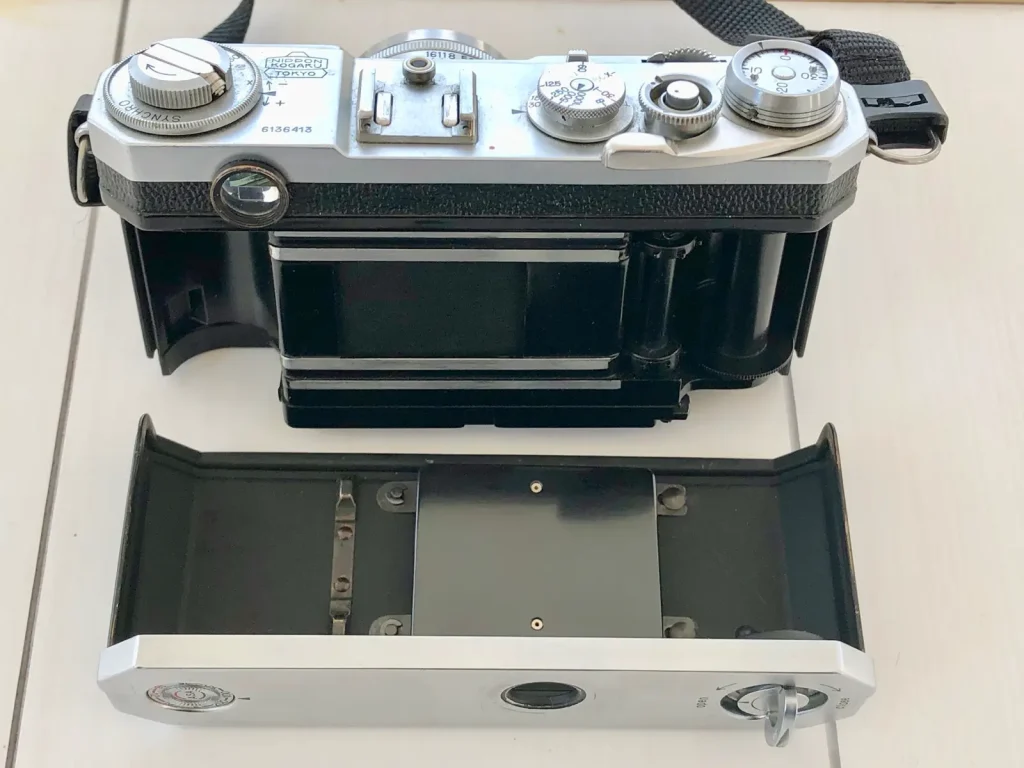
The S2 also sports a film advance thumb lever like on the Leica, as opposed to the winding nob on previous Nikon models. It is single stroke, not double.
The S2 is substantially lighter than the Leica because it is made of some kind of aluminum alloy as compared to the brass of the M3. It feels good and light in the hand while still having just enough heft, and puts less strain on my neck.
And then there is the shutter. Releasing the shutter on the Nikon is loud. It bellows a deep-throated, chunky ka-clunk. It is audible to people around you even shooting on the street. It is loud enough to scare up water fowl in a marsh if you happen to be shooting landscape, and there is also the risk of shutter shake. The shutter is nothing like silky smooth soupçon of a click of the Leica M3.
And what about the Nikkor H C 50mm f/2 lens? It is no Summicron, but frankly, I can’t tell the difference in sharpness on film, and I don’t think anyone else could either, hence the reputation of Nikon as a Leica alternative among pros of the era. The bokeh is no better or worse than that of the Summicron 50mm in my opinion, but in any case, you don’t buy an f/2 lens for the bokeh.
So the Nikon S2 is a workhorse rangefinder. It was good enough for most pros at a fraction of the cost of the rival Leica M3 while incorporating most of the Leica features, and adding a few features Leica did not offer. Nikon just did OK with the S2, selling about 56,000, an order of magnitude less than the Leica M3. So Leica clearly came out on top. That is until Nikon introduced is Nikon F SLR, making all rangefinders seem quaint and passé, relegating Leica to niche status among pros and consumers alike.
I have posted a few shots taken with the Nikon S2 in Asakusa, Tokyo. If you are curious, the film used is Kodak T-MAX 100.



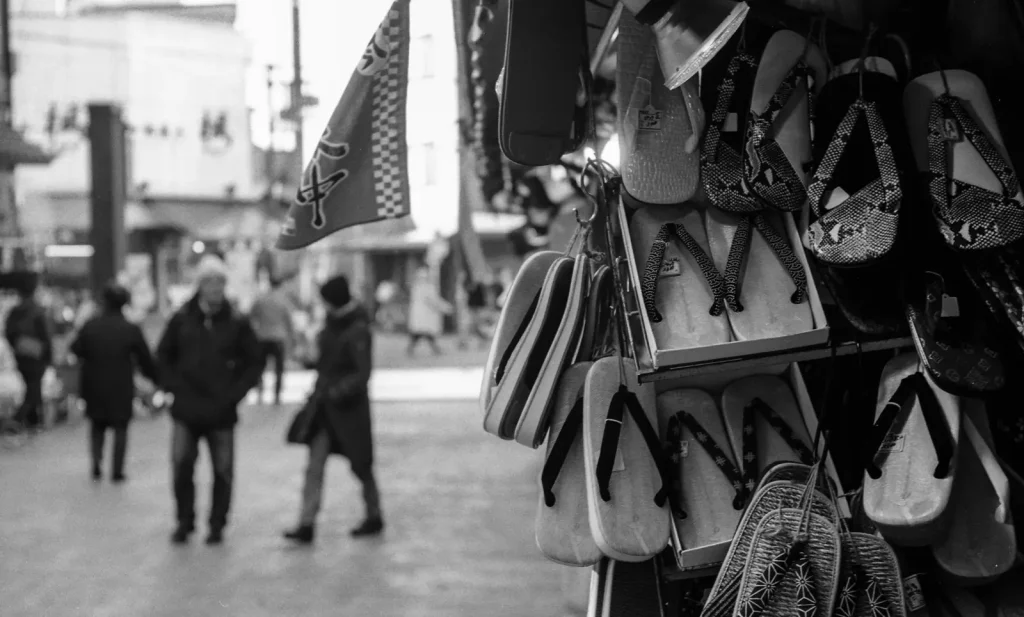
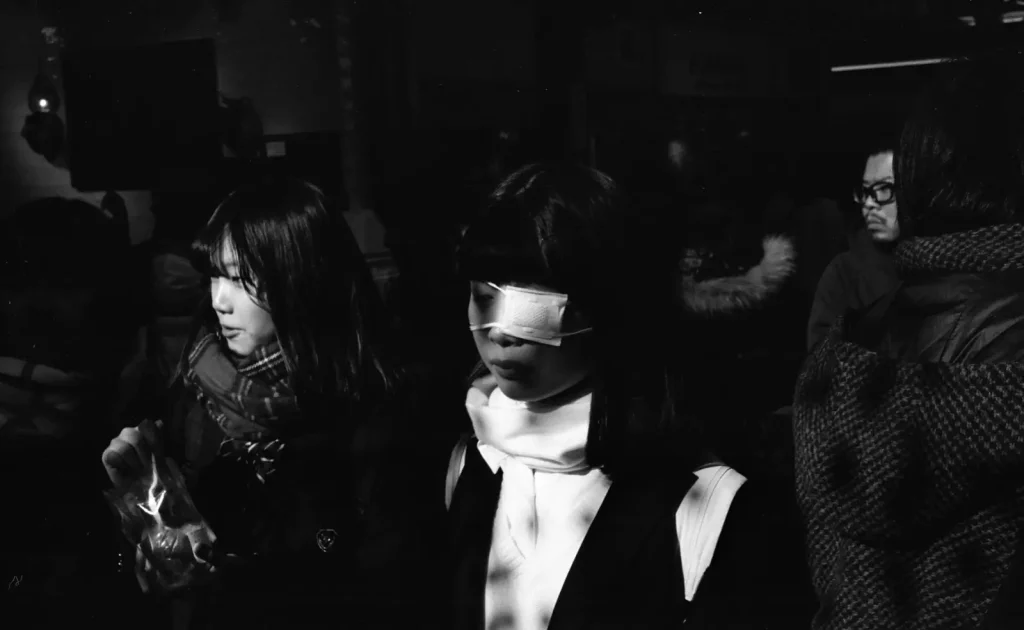
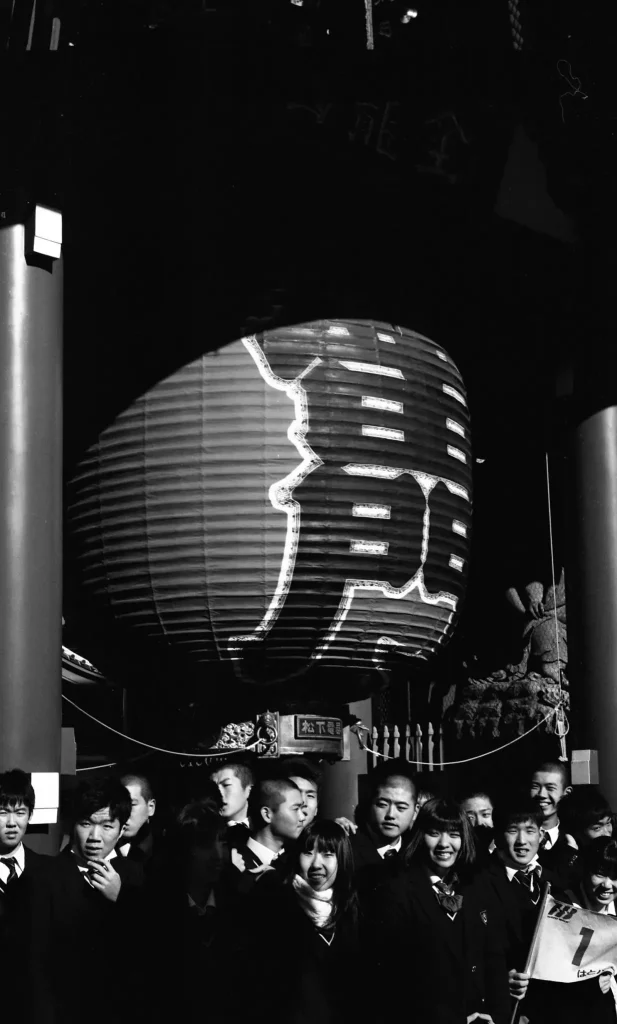
You can see more of my work at www.bleisteinphoto.com and on Instagram @sbleistein.
Share this post:









Comments
StephenJ on Nikon S2 Review – Upstart Rival to the Leica M3 – By Steven Bleistein
Comment posted: 05/01/2019
I have also owned a Mandler 50 Summicron, the latest version, and I currently own the ten bladed version of the Summitar. I am a bit of a 50 nut, as in addition for a short while I had the S2 but with the f1.4 Nikkor. I did some tests of the two Nikkors and the Summicron on my M4, I used an M converter for the f1.4 Nikkor, I shot a roll of FP4, and I liked the Nikkors better, but didn't like the M converter, so I sold the S2 with f1.4, the converter and the Summicron, later I bought the Summitar which is collapsible.
Not really gone mad with the Summitar yet, since I have also recently acquired a 40mm Summicron, which I love, even though it is really a Minolta lens.
The S2 is great and very much under appreciated, but I used to get frustrated by the fact that the film winds on the wrong way round and then becomes difficult to load onto the developing spool.
Even though I sometimes regret selling the Summicron, since it handles colour so gloriously, the Nikkor is overall a nicer lens and it fits onto LTM cameras too, as does the Summitar., and I like the character of the older lenses (including the uncomplicated bokeh).
Oh and the M4 is my favourite M camera, it is the best built of the proper M cameras, has the best compromise regarding frame lines, and the whole thing is what they call buttery smooth.
Comment posted: 05/01/2019
stevenbleistein on Nikon S2 Review – Upstart Rival to the Leica M3 – By Steven Bleistein
Comment posted: 05/01/2019
Terry B on Nikon S2 Review – Upstart Rival to the Leica M3 – By Steven Bleistein
Comment posted: 05/01/2019
It isn't easy today to fully comprehend just what an impact the M3 had when it was launched. And I'm sorry to disagree with you regarding the S2 as a worthy competitor as apart from its 1:1 viewfinder it is, and already was very much outdated at the time of its release. No v/f frame lines, no parallax correction, rotating twin co-axial shutter speed dials for slow and fast speed ranges which weren't even on the Contax IIa on which the S2 takes its design clues; this type of shutter speed setting, separate dials, was last seen on the last screw Leicas, or their clones.
Film loading utilising removable backs or removable base plate is very much a personal thing. As for myself, although I love my Contaxes, II/III/IIa/IIIa, very much, I did find loading them slightly more of a chore than my M3 or even my IIIf. What a removable back does permit, I agree though, is no need for a specially trimmed film leader and which ideally is needed to more easily load an older Leica. An advantage of the S2 is the permanently attached take-up spool, so loading should be less troublesome than with my Contaxes. Incidentally, regarding loading an M3, I did read of one respected Fleet Street photographer who went on assignment with his films already attached to M take up spools so reloading could be carried out quite quickly and under the circumstances I'm sure much faster than coping with a removable back and I'm guessing much quicker than conventional cameras with hinged backs and fixed take up spools. A press photographers trick of the trade, I gather.
As for other cameras with a 1:1 v/f, in addition to Nikon's own S3 and S4, there are two of which I am aware. The Canon P and the Cosina/Voigtlander Bessa R3A, which I've read has the best v/f ever fitted to an M-mount camera.
One final comment concerns the lens mount used on the Nikon. It should correctly be described as Contax rangefinder, and not C-mount. True C-mount lenses are the standard for 16mm cine cameras; the amateur home cine version being the smaller D-mount.
Comment posted: 05/01/2019
Comment posted: 05/01/2019
Comment posted: 05/01/2019
Comment posted: 05/01/2019
Comment posted: 05/01/2019
Comment posted: 05/01/2019
Comment posted: 05/01/2019
Comment posted: 05/01/2019
Enrico Pietro on Nikon S2 Review – Upstart Rival to the Leica M3 – By Steven Bleistein
Comment posted: 05/01/2019
Reliable, precise, compact and full of modern features. Can't wait to buy back one.
Mike Hinkleman on Nikon S2 Review – Upstart Rival to the Leica M3 – By Steven Bleistein
Comment posted: 05/01/2019
I don't like the focusing tied to the thumb wheel which takes pressure force and can be a pain to the finger. The 50mm viewfinder clear and bright. Film loading better than a Leica screw mount but not much. Changing lenses quicker than ltm.
Hard to beat the M3 finder except of course no 35mm frame. M2 solves that.
You might in the future consider the Canon 7/7s. Nice right finder, metal curtains, swing back film loading. Light meter on board. A black Canon 7 is a thing of beauty !
Winner: M3/M2. You'll want both.
Kodachromeguy on Nikon S2 Review – Upstart Rival to the Leica M3 – By Steven Bleistein
Comment posted: 05/01/2019
https://www.cameraquest.com/NRFS3 2000.htmFantasies
A few years ago, the prices for these new Nikons were surprisingly reasonable, but I am not sure now. Most of the analog film machinery is climbing in price as of 2018 2019.
David Smith on Nikon S2 Review – Upstart Rival to the Leica M3 – By Steven Bleistein
Comment posted: 05/01/2019
eric on Nikon S2 Review – Upstart Rival to the Leica M3 – By Steven Bleistein
Comment posted: 06/01/2019
It has 3 major "problems":
- no wide angle frame lines
- way of loading film
- the most important, the weight because it is build like a tank !
But one of the finest machine on earth like some famous swiss watch and with a Leica lense or a few magic Ltm lense in 50 mm this the best photographic tool because : silent, keep film very well film stay precisely but not too much press and straight which improve the sharpness and magic pleasure to use.
The best camera on earth
Comment posted: 06/01/2019
paradroid on Nikon S2 Review – Upstart Rival to the Leica M3 – By Steven Bleistein
Comment posted: 06/01/2019
Comment posted: 06/01/2019
Zachary Archer on Nikon S2 Review – Upstart Rival to the Leica M3 – By Steven Bleistein
Comment posted: 03/03/2019
Comment posted: 03/03/2019
Bud Sisti on Nikon S2 Review – Upstart Rival to the Leica M3 – By Steven Bleistein
Comment posted: 16/03/2021
I shoot Leicas, and I also have two S2 cameras with 28, 35, and 50 lenses. I do prefer the Leicas, but the Nikons have their place. I live in the American Southwest, an environment that eats cameras alive, and I like to shoot small local rodeos. For that, it's the indestructible, pound-nails-with-them Nikons. They do the job, always, and have never needed expensive servicing. Wish I could say as much for the Leicas!
Dismayed on Nikon S2 Review – Upstart Rival to the Leica M3 – By Steven Bleistein
Comment posted: 25/07/2021
Leica never had much expertise in electronics, and the fiasco with 'sensor corrosion' on the M9 was a disaster.
Comment posted: 25/07/2021